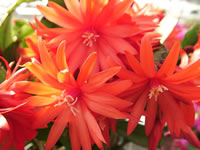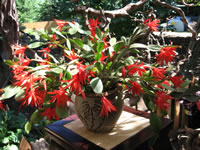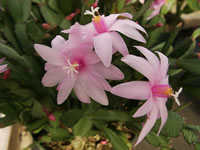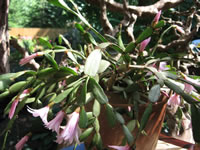How to Grow and Care for Easter Cactus Plants
Rhipsalidopsis gaertneri and Rhipsalidopsis rosea
 
       
Like the Christmas and Thanksgiving Cactus, Easter or Spring Cactus, as they are also known,
are epiphytic plants that are native to the tropical jungles of Brazil.
The Dwarf Easter Cactus, Rhipsalidopsis rosea produces soft pink, 1"-2" flowers.
Rhipsalidopsis gaertneri produces bright red flowers that can reach 3".
This species of Easter Cactus has been vigorously hybridized with R. rosea and various Epiphyllums
to create many new varieties in colors ranging from pure white to bright purple.
Both species of Easter Cactus bloom early in the spring, and will occasionally flower again in the fall. |
 |
Growing Requirements for Spring and Dwarf Easter Cactus
Spring and Dwarf Easter Cactus are frost tender plants that are only hardy in USDA zones 9-12,
but they are reasonably easy to grow and maintain as house plants.
As with growing most other house plants, Easter Cactus grow best in an environment that is
close to their native habitat... Fortunately, however, these plants are quite willing to adapt.
In the garden, Easter Cactus should be grown in planters or hanging baskets in dappled to full shade.
They will tolerate some morning or late afternoon sun in coastal or temperate regions.
Indoors, these plants should be grown in bright, indirect light,
but never in full sun, in an area with good air circulation.
Easter Cactus can survive in temperatures from 35° to 100°,
but to thrive, they need daytime temperatures of 70°-80° with 10° cooler at night.
|
|
|
Planting and Repotting Easter Cactus Plants
Excellent drainage is essential for both the planter and the planting mixfor your Easter Cactus to survive.
Easter Cactus should be grown in a light, fast draining, peat moss based planting mix with coarse builders sand or perlite added.
Water actively growing Easter Cactus thoroughly when the top inch of soil becomes dry to the touch.
Never allow the pot stand in water for more than an hour. Waterlogged soil can quickly lead to root rot and disease.
Established, healthy Easter Cactus plants should be fed monthly beginning in late February until September,
using a soluble fertilizer with an NPK ratio of 10-10-5.
Rhipsalidopsis plants will become semi-dormant in the fall and winter months, while they are setting new buds.
During this time, they should be kept in a cooler spot (50°-60°) and watering should be cut back to once or twice a month.
Easter Cactus bloom best when they are somewhat rootbound and crowded, but they should be repotted in fresh potting mix every other year to a pot that is one size larger. Repotting should be done in mid-summer after blooming or in the fall.
Easter Cactus are prone to attacks from slugs and snails,
spider mites and mealy bugs.
Propagating Easter Cactus Plants
Easter Cactus can be easily propagated by cuttings of segments taken during the summer after your plant has finished blooming.
Cut or gently twist off single or multiple segments from the tips of the healthy branches. Be sure to keep track of which end of the cutting is 'up'.
Set the segments in a cool, dry location for several days,
to allow the cut ends to form a callous. Insert the base of the cutting ½" deep in moist sand, perlite or vermiculite mix.
When the new roots are well established, move your new Easter Cactus to an appropriate container in a rich, fast draining potting mix.
|
|
Spring Cactus
Rhipsalidopsis gaertneri
 |
 |
|
Dwarf Easter Cactus
Rhipsalidopsis rosea
 |
 |
|
|
|
|
Search The Garden Helper:




